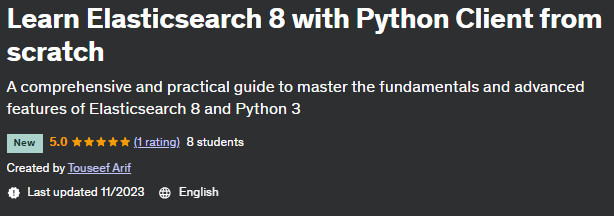Description
Learn Elasticsearch 8 with Python Client from scratch course. Hello, I am a software architect with 10 years of experience in software development. I’ve created a tutorial for you to learn Elasticsearch 8 with the Python client from scratch. This course teaches you how to use Elasticsearch, a powerful and scalable search engine, to store, search, and analyze large volumes of data. You’ll also learn how to use Python, a popular and versatile programming language, to interact with Elasticsearch and build a web application API using Flask, a lightweight web framework. This course is designed for beginners who want to learn the basics of Elasticsearch and Python, as well as for intermediate and advanced users who want to deepen their knowledge and skills. The course is divided into 40 lectures, each covering a specific topic and providing practical examples and exercises. At the end of this course, you will be able to:
- Install and configure Elasticsearch 8 with Kibana, a web interface for visualizing and managing your data
- Understand basic Elasticsearch concepts and features such as shards, replicas, indexes, documents, mappings, parsers, queries, filters, and aggregates.
- Perform various operations on your data, such as indexing, retrieving, updating, deleting, searching, sorting, and aggregating.
- Use the elasticsearch-py module, the official Python client for Elasticsearch, to connect and interact with your Elasticsearch cluster.
- Use the elasticsearch-dsl module, a high-level library that simplifies working with Elasticsearch in Python.
- Perform fuzzy and full-text search, as well as search by date and geographic data
- Optimize your search performance using navigation scrolling, pagination, and other techniques
- Install and use Docker, a tool that allows you to run applications in isolated containers, run Elasticsearch and Kibana in a virtual environment.
- Build a Flask web application that uses Elasticsearch as a backend to store and search for products
- Error and exception handling in Elasticsearch and Python
- Learn best practices and tips for working with Elasticsearch and Python
This course is based on the latest version of Elasticsearch (8.x) and Python (3.x). You will need a computer with an Internet connection and a web browser to access the course content and Elasticsearch and Kibana web interfaces. You should also install Anaconda, a distribution of Python that includes many useful packages and tools, and PyCharm, an integrated development environment (IDE) that makes coding easier and more enjoyable. This course guides you through the steps of installing and setting up these tools. If you are interested in learning Elasticsearch 8 with the Python client from scratch, this course is for you. You will gain valuable knowledge and skills that will help you in your personal and professional projects. You will also enjoy and enjoy the learning process. So what are you waiting for? Sign up now and start your journey with Elasticsearch and Python!
What you will learn in the Learn Elasticsearch 8 with Python Client from scratch course
-
How to install and configure Elasticsearch 8 with Kibana, a web interface for visualizing and managing your data
-
How to understand the core concepts and features of Elasticsearch, such as shards, replicas, indexes, documents, maps, parsers, queries, filters, and aggr
-
How to perform various operations on your data, such as indexing, retrieving, updating, deleting, searching, sorting, and aggregating
-
How to use the elasticsearch-py module, the official Python client for Elasticsearch, to connect to and interact with an Elasticsearch cluster
-
How to use the elasticsearch-dsl module, a high-level library that simplifies working with Elasticsearch in Python
-
How to perform fuzzy and full text search as well as search with date and geographic data
-
How to optimize your search performance using caching, pagination, and other techniques
-
How to install and use Docker, a tool that allows you to run applications in isolated containers, run Elasticsearch and Kibana in a virtual environment.
-
How to build a Flask web application that uses Elasticsearch as a backend to store and search products
-
How to handle errors and exceptions in Elasticsearch and Python
-
How to learn best practices and tips for working with Elasticsearch and Python
This course is suitable for people who
- Data analysts and scientists who want to explore and visualize their data using Elasticsearch and Kibana.
- Web developers who want to build fast and scalable web applications using Elasticsearch and Flask
- Software engineers who want to learn how to design and implement efficient and reliable search systems using Elasticsearch and Python
- Enthusiasts and hobbyists who want to learn new and exciting technologies and concepts
Course specifications Learn Elasticsearch 8 with Python Client from scratch
- Publisher: Udemy
- teacher: Touseef Arif
- Training level: beginner to advanced
- Training duration: 5 hours and 54 minutes
- Number of courses: 40
Course topics Learn Elasticsearch 8 with Python Client from scratch
Prerequisites of the course Learn Elasticsearch 8 with Python Client from scratch
- A basic understanding of Python programming, such as variables, data types, functions, loops
- A computer with an internet connection and a web browser
- A willingness to learn and explore new technologies and concepts
Course images
Sample video of the course
Installation guide
After Extract, view with your favorite Player.
Subtitle: None
Quality: 720p
download link
File(s) password: www.downloadly.ir
Size
1.9 GB
